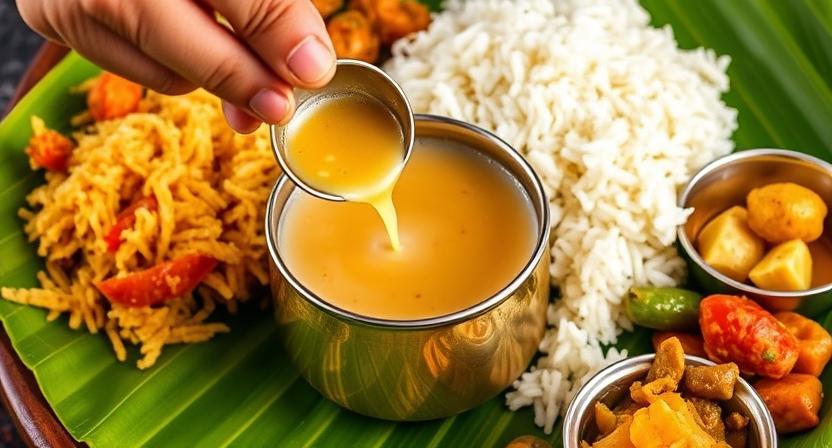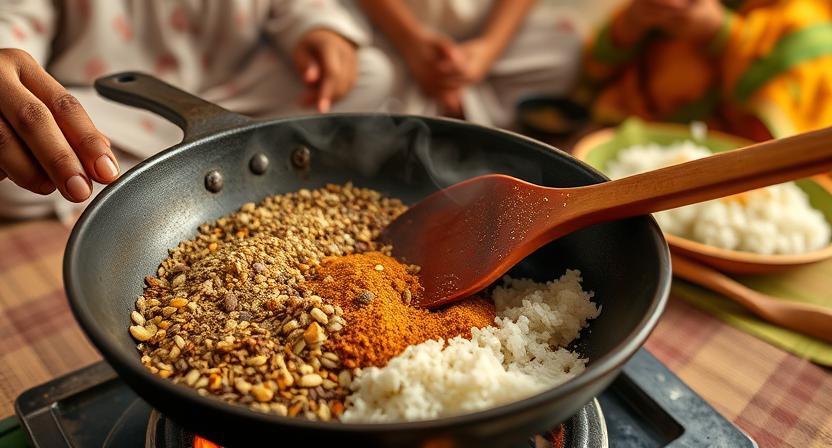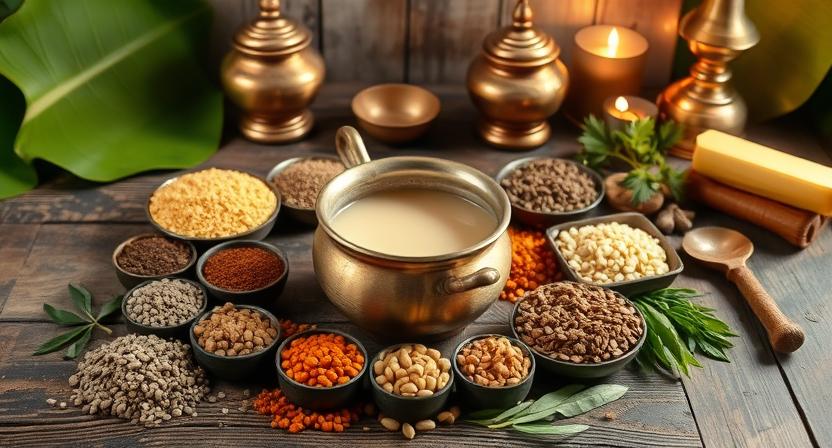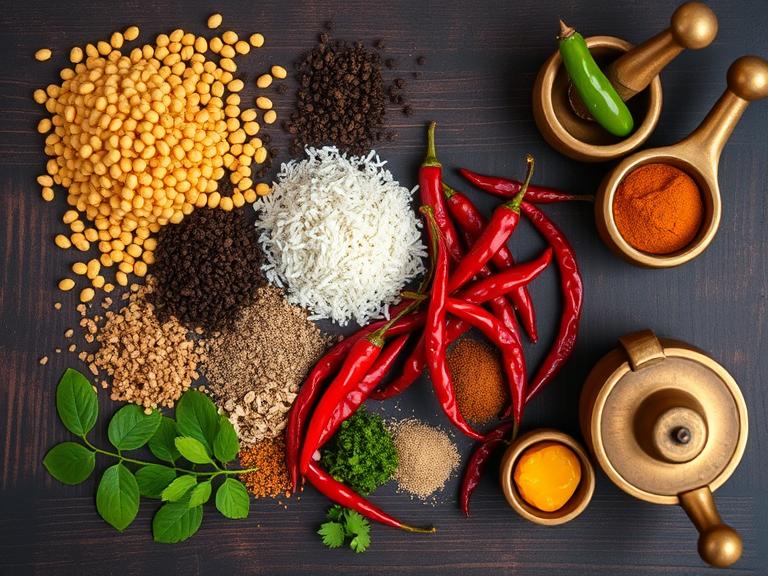Meta Description:
Learn how to make Devasthana Saaru, a flavourful and historically significant traditional temple-style rasam, using the traditional Konkani recipe. Detailed instructions with ingredients, advice, and suggested serving sizes.
Introduction to Konkani Recipe Devasthana Saaru
A classic Konkani meal that is frequently served during temple feasts and religious events is Devasthana Saaru, sometimes called Temple-Style Rasam. This recipe is different from other rasams because it captures the aromatic essence and heavenly simplicity. This soulful and calming saaru, which is made with few ingredients but has a lot of flavour, is a mainstay in many Konkani homes.
Let’s examine the detailed process for making Devasthana Saaru, a traditional Konkani dish that comes directly from the temple kitchens of Goa and coastal Karnataka.
Step-by-Step Guide to Make Konkani Recipe Devasthana Saaru
H2: Ingredients You’ll Need
For the Saaru Base
- Half a cup of toor dal, or pigeon peas
- One medium tomato, chopped
- A dash of turmeric
- Add salt to taste.
- Three cups of water
H3: For the Spice Paste (Masala)
- Two teaspoons of coriander
- One teaspoon of cumin seeds
- Four to five dry red chillies (for colour, Byadgi is preferable)
- Half a teaspoon of black peppercorns
- A tamarind slice the size of a stone
- One teaspoon of optionally grated coconut
- One teaspoon of oil (to roast)
For Tempering
- One teaspoon of mustard seeds
- One curry leaf sprig
- A pinch of asafoetida, or hing
- One or two dried red chillies
- One teaspoon of ghee

Step 1 – Cook the Dal
First, give the toor dal a good cleaning. Add water and turmeric and pressure cook until it’s tender (3–4 whistles). After thoroughly mashing the dal, set it aside.
Step 2 – Prepare the Masala
Heat the oil in a small pan. Add the red chillies, cumin, pepper, and coriander seeds. Roast until fragrant. After adding the coconut and tamarind, turn off the heat. Allow it to cool a bit, then use a little water to crush everything into a smooth paste.
Step 3 – Make the Saaru
Add the ground masala paste, diced tomato, mashed dal, and enough water to adjust the consistency in a deep saucepan. Bring to a slow boil after adding the salt. Simmer for 5 to 7 minutes, or until all the flavours are harmoniously combined.
Step 4 – Add Tempering
Heat ghee in a small kadai. Let the mustard seeds sputter after adding them. Add the red chillies, curry leaves, and hing. To preserve the scent, pour this tempering over the saaru and cover right away.
Step 5 – Serve & Enjoy
The ideal way to enjoy Devasthana Saaru is hot, with steamed rice and a little ghee on top. For a hearty Konkani-style dinner, serve it with pickle and papad or a straightforward vegetable upkari (dry stir-fry).
Tips to Make the Best Konkani Recipe Devasthana Saaru
- For deep colour without overpowering heat, use Byadgi chillies.
- Tempering the ghee is crucial because it intensifies the wonderful aroma of the saaru.
- To maintain it sattvic and temple-style, stay away from garlic and onions.
- Tamarind provides tang, so taste and adjust accordingly.
Why Konkani Recipe Devasthana Saaru Is Special
- Spiritual roots: Frequently made as a festive naivedyam (offering).
- Simple ingredients with complex flavours.
- Ideal for all age groups, it is simple to digest.
- A soothing, warm rasam that’s ideal for chilly or wet days.
Conclusion
More than just a meal, this Konkani food, Devasthana Saaru, pays homage to temple culture and heritage. It is a perennial favourite among the Konkani community because of its purity, simplicity, and harmony of flavours. This recipe is a must-try whether you’ve never tried Konkani food before or are trying to reproduce nostalgic flavours.
Nutritional Benefits of Konkani Recipe
In addition to being tasty, Devasthana Saaru is also nourishing and therapeutic. The spices like cumin, pepper, and hing help with digestion and digestive health, while the toor dal offers plant-based protein. This rasam is a nutritious dinner choice since the ghee used for tempering adds healthy fats and improves nutrient absorption.
Variations of Temple-Style Saaru Across Regions
Similar varieties can be found in temples in Udupi, Mangalore, and South Canara, although the Konkani Devasthana Saaru has a unique flavour character. Some substitute a jeera rasam base for the coriander-forward masala, or add jaggery for a subtle sweetness. Each variation reflects the local traditions and ingredients used by temple cooks.
Common Mistakes to Avoid When Making Konkani Recipe
Even though the recipe is simple, a few mistakes can affect the authentic flavor:
- The saaru may become bitter if the spices are overcooked during roasting.
- The delicate temple-style flavour can be overpowered by using too much tamarind.
- The aroma and depth of flavour are diminished when the ghee tempering is skipped.
- If you add garlic or onion, it isn’t “Devasthana-style.”
Avoid these to get the perfect, traditional taste every time.
Ideal Occasions to Serve Konkani Recipe Devasthana Saaru
Devasthana Saaru is traditionally served during:
- Holidays such as Rama Navami and Ganesh Chaturthi
- Community lunches and temple feasts (Anna Santarpane)
- Days of religious fasting because they are sattvic and devoid of garlic and onions
- Comfort food meals, particularly while ill or during the monsoon season
This saaru is ideal for both regular comfort dinners and religious gatherings.

How Devasthana Saaru Differs from Regular Rasam
While both Devasthana Saaru and regular rasam share some ingredients, key differences include:
- Devasthana Saaru is sattvic for temple offerings; no garlic nor onions are allowed.
- A special spice blend that emphasises Byadgi chillies and coriander
- The presence of dal results in a thicker consistency.
- A unique scent reminiscent of a temple from the ghee-based tempering
These distinctions make Devasthana Saaru feel more spiritual and ceremonial than everyday rasam.
Storage and Reheating Tips
Want to enjoy Devasthana Saaru over a couple of days? Here’s how:
- Keep leftovers in the fridge for up to two or three days in an airtight container.
- Avoid using a microwave as it may alter the flavour; instead, reheat slowly on the stove.
- If, after chilling, the saaru thickens, add a splash of hot water.
- Reheat with fresh tempering if you want to revive the aroma before serving.
Traditional Ingredients Sourced from Konkani Homes
- The utilisation of traditional, locally sourced ingredients is what really sets Devasthana Saaru apart:
- Byadgi chillies for their mild heat and vivid colour
- For added richness, you can include either fresh or dry shredded coconut.
- Pulp from tamarinds for real tanginess
- Ghee prepared at home for the ideal scent of tempering
These ingredients reflect the purity and authenticity of Konkani temple cuisine, passed down through generations.
Pairing Suggestions: What to Serve with Konkani Recipe
To enjoy a complete Konkani-style meal, serve Konkani Recipe with:
- A spoonful of butter and some steamed rice
- Stir-fried ivy gourd, or Tendli Upkari
- For a spicier side, try Patrado or batata song.
- Pickles and Papad for flavour and crunch
These traditional pairings enhance the saaru comforting, well-balanced flavor profile.
Why Konkani Recipe Devasthana Saaru Is Loved Across Generations
This saaru isn’t just a recipe — it’s a nostalgic connection to temple feasts, family traditions, and spiritual rituals. Its simple preparation and soulful taste make it a comfort food that resonates with elders and younger generations alike. The recipe is often passed down as a treasured family heirloom, keeping Konkani culinary heritage alive.
The Cultural Significance of Devasthana Saaru in Konkani Cuisine
In Konkani culture, Devasthana Saaru is more than just a tasty food; it is a representation of community, history, and spirituality. It symbolises the cleanliness of temple food and the significance of sattvic meals and is prepared for festivals, sacred rites, and temple rituals. Serving this saaru is a reflection of hospitality, devotion, and the long-standing culinary traditions of Goa and coastal Karnataka.

Final Thoughts: Bringing Temple Traditions to Your Home Kitchen
A lovely approach to respect long-standing temple customs and introduce your family to the core of Konkani spirituality through cuisine is to prepare Devasthana Saaru at home. You may offer a dinner that is both incredibly cosy and culturally rich with just a few simple ingredients and careful preparation. It can end up becoming a weekly meal staple if you give it a try.
